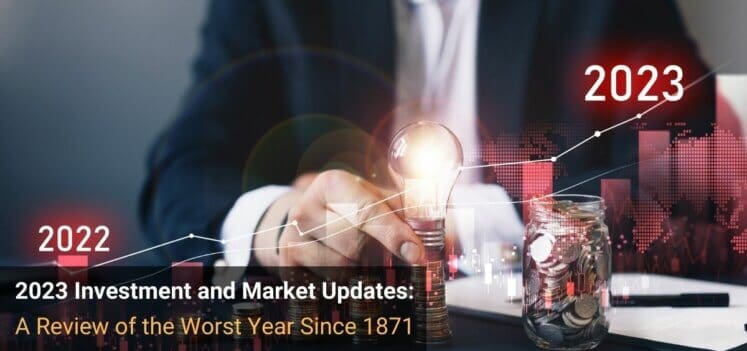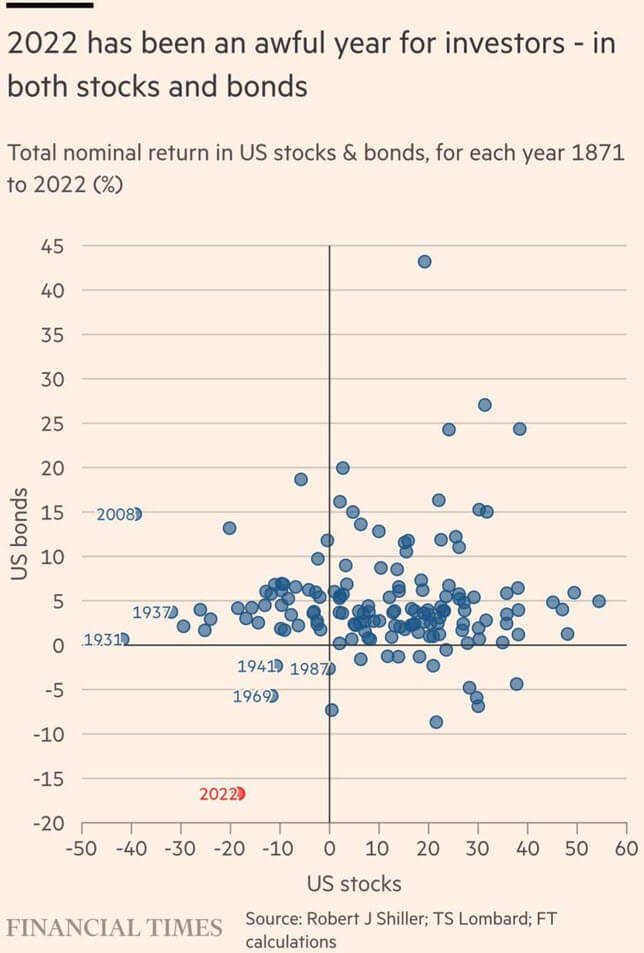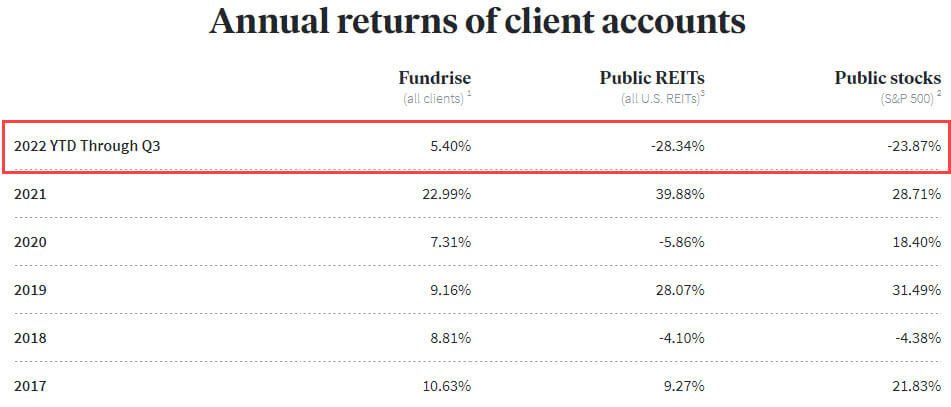2023 Investment and Market Updates: A Review of the Worst Year Since 1871

Any discussion of the financial markets in 2022 needs to acknowledge one important fact upfront: it was the worst year for stocks and bonds since at least 1871.
Just look at the handy chart the Financial Times put together to see the horrifically bad numbers:

In January 2022, everything seemed quite frothy, with mega-deals happening left and right and crypto and equity prices still at high levels.
But then February came, Russia invaded Ukraine, and everything went downhill from there.
In March, the Fed finally started hiking rates, and in May and June, the pace accelerated; the federal funds rate ended the year in the 4.25% – 4.50% range, the highest level since 2007.
Inflation proved not-so-transitory, and it persisted in the high-single-digit range despite interest-rate increases in almost every major country.
Inflation is now decreasing, allegedly, but the percentage is still much higher than it has been at any time since the early 1980s (and that’s not factoring in the “methodology changes”).
Meanwhile, disasters kept emerging in the riskiest parts of the market, such as crypto (see: FTX, Celsius, etc.), SPACs, and growth/speculative stocks.
This year was so bad that it’s pointless to talk about “performance.”
A better question might be: “So, how much were you down by?”
My Answer: 11%, which was bad but considerably less bad than the S&P 500 or Nasdaq.
I’ll address several topics in this year’s update, starting with my current portfolio and performance stats and ending with some predictions that will probably be wrong:
My Current Portfolio and Performance Stats
Here it is as of January 3rd, with differences vs. the start of 2022 in brackets:
- Equities: 31% [Down 7%]
- Short-Term U.S. Treasuries: 19% [Up 19%]
- Real Estate (Equity Funds + Owned Properties): 15% [Up 5%]
- Cash & Savings: 11% [Down 3%]
- Gold: 10% [Unchanged]
- Natural Resources & Commodities: 5% [Up 4%]
- Angel Investments: 5% [Up 1% – recording these at historical cost – see below]
- Silver: 3% [Unchanged]
- Real Estate – Senior Secured Loans: 1% [Down 2%]
- Crypto: 0.01% [Down 15.63%]
And my performance stats are as follows:
- 2019: +36%
- 2020: +38%
- 2021: +25%
- 2022: –11%
- Total Gain Over Pre-Covid Market Levels: +54%
On the one hand, I beat the S&P 500 and Nasdaq in 2022 and the S&P in two of the other three years.
On the other hand, I fell far short of my goal: being up by 10% in the “downside case.”
Also, as deal activity and hiring fell at banks, this business performed poorly for the year.
My plan to focus on the market or my “full-time job” didn’t work well because they were closely correlated over the past 12 months.
The main reasons I outperformed the S&P and Nasdaq in 2022 were:
- Good-But-Not-Perfect Timing with Crypto – I sold most of my position in Q4 of 2021 into Q1 of 2022, missing the peak but still selling at a high enough level to earn a ~4x overall gain, mostly on purchases made in 2020 and some as far back as 2017 and 2013.
- Real Estate and Precious Metals – Many of these assets stayed the same or even increased in 2022. For example, look at the rally in silver prices in the last two months of the year.
- (Some) Value Orientation in Equities – I had very little allocated to growth/speculative stocks, which were hammered this past year. I was not as value-oriented as I should have been, but modest exposure still helped.
- No Exposure to Bonds – As I predicted last year, bonds performed horribly in 2022 due to rising inflation and rising rates. I sold my U.S. Treasuries in March 2020, when rates fell to 0%, and didn’t buy in again until the end of 2022.
Overall, I consider my performance disappointing because I could have been closer to breakeven or positive for the year if I had done a few things differently (see below).
What I Changed Since Last Year
The smartest move I made in the entire year was selling most of my remaining crypto in Q1.
Unfortunately, I stupidly put the proceeds into a mix of equities and precious metals rather than keeping them in cash or just precious metals.
The article about the FTX bankruptcy summarizes my views on crypto, and I don’t have much to add here.
In short, it is not an inflation hedge, it’s not a store of value, and it’s not a real “currency.”
It’s a speculative risk asset that rises when monetary policy loosens and falls when policy tightens.
I currently have almost nothing in it – just a few coins I couldn’t sell via Coinbase – but I might start buying again if central banks revert to easy money.
Toward the end of the year, I also sold ~20% of my publicly traded assets and put the proceeds in short-term U.S. Treasuries (maturities of 1-3 years).
My logic here was:
- With an inverted yield curve and interest rates that are still set to rise, there’s no point buying longer-term UST, such as 10-20-year bonds, when I earn more on shorter-term ones and assume far less interest-rate risk.
- TIPS (Treasury Inflation-Protected Securities) were not an option because of the low purchase limits and other restrictions. And this is very much a short-term trade, so I don’t care much about 4-5% vs. 6-7% over a year or less.
- If the markets continue to fall or stagnate, I’d rather earn a 4-5% yield on UST than nothing or a negative amount on equities.
So far, this change is in the “neutral” category.
Right after I moved ~20% to Treasuries, equities rose and then fell again, so I can’t say how this will play out.
Finally, the S&P 500 put options I purchased in 2020 expired worthless in December 2022.
This happened mostly because I got the timing very wrong.
I was expecting a 15-20% market correction to the S&P in 2020 or early 2021 due to a new covid variant, war, or some other disaster.
We did get a new variant, a war, and other disasters, but they all happened toward the end of 2021 into 2022, and by that time, the S&P had risen to much higher levels.
Meanwhile, the exercise prices on my put options were around 3,000 or less.
I don’t think it was “wrong” to buy put options as a hedge; my mistake was not doing it incrementally over time, always staying just below the current S&P price.
Options purchased in 2020 still would have expired worthless, but I would have earned something on most of the 2021 purchases.
Are Private Market Numbers Real?
One final note here: there seems to be a huge divergence between the public and private markets, and I’m not sure I buy it.
For example, Fundrise, which offers private real estate funds, claims these performance stats for 2022 Q1 – Q3 vs. public REITs:

Meanwhile, AngelList claims that the value of my angel investments increased so much in 2021 – 2022 that I’ve earned a multiple of just over 4x.
I think the actual multiple is probably closer to 2-3x, and I find it odd that they did not adjust down the market values, given what happened everywhere else in 2022.
With Fundrise, properties in some regions have held up better than others, but I’m not sure I believe their private funds outperformed public REITs by ~34%.
In many cases, these funds are delaying their mark-downs of private assets, so their values still seem inflated vs. the public markets.
My Not Great, Not Horrible Performance
I mentioned above that while I did outperform a few major indices for 2022, I also made some mistakes that explain my 11% drop.
Here’s my list of excuses explanations:
- Lack of a “Fed Pivot” – I thought they would back off once the S&P had fallen by 10-15%, but they dug in their heels, surprising me and most others.
- Emerging Markets and the Strong USD – Although I’m overweight value stocks, I also put ~1/3 into U.S. stocks, ~1/3 into non-U.S. developed markets, and ~1/3 into emerging markets. These other indices fell by about as much as the S&P 500 for the year, and the strong U.S. dollar further depressed gains.
- Suboptimal Indices/ETFs – While I had a tilt toward value, many of the indices and funds I used were not as fully in the “value” category as they could have been.
As an example of this last problem, consider two “value” funds: the Vanguard International High Dividend Yield Index Fund and the International Value Fund.
They both invest in large-cap foreign stocks, but the “High Dividend Yield” fund was down by 7% for the year, while the value one was down by 12%.
This 5% difference might seem small, but these types of differences add up over a large portfolio (and no, the difference in dividend yields cannot explain the entire difference.)
Even if a fund is labeled “value,” you cannot assume it belongs there.
My biggest mistake was doing only cursory research on different funds, partially because I am spread out over many different accounts.
It would have been smarter to stick to a smaller group of funds – 5-10 total – and thoroughly learn the holdings and strategies of each one.
And when it became clear in May that the Fed would increase rates more aggressively, I should have immediately sold my public equities and put the proceeds in cash or dividend-focused funds.
Plans for My Future Portfolio and Thoughts on Everything Since 2020
There are “Glass Half Full” and “Glass Half Full” versions of my performance over these past few years:
- Glass Half Full: I’m still up over 50% over pre-covid market levels, despite spending almost no time managing my portfolio and making only occasional, targeted trades.
- Glass Half Empty: If I had been more aggressive in 2020 – 2021, I could have been up 100% or more.
These observations also bring up a broader issue.
Over the past 5-10 years, I’ve taken a “mostly passive” approach to investing by putting money into indices and automated solutions like Wealthfront, assuming that my time would be better spent growing this business.
Unfortunately, that assumption is no longer true, so I’ll need to change my approach.
These days, a ~10% change in my assets would dwarf a 10% change in my business income (order-of-magnitude difference).
And that assumes that I could even increase my income by 10% – which is difficult when the “finance careers / financial modeling” market is saturated, with dozens of copycat sites, plagiarized articles, AI-produced courses, etc.
After ~15 years of this, there are diminishing returns to spending 60-70 hours per week creating content.
I’m not going to shut anything down, stop writing, or sell the site, but I also can’t justify spending 99% of my working hours on this business.
So, my new approach will be:
- Move most of my equity holdings to dividend funds. I expect these to outperform while interest rates are high(er) and the economic outlook is weak.
- Research and invest in individual stocks and move some of my cash and UST into specific stocks over time (I may turn some of this into new articles as well).
My stock picks, such as Avalon Bay and Jazz Pharmaceuticals, have done well over their selected time frames.
But I didn’t put in enough money to see huge gains from these picks.
I aim to earn at least 5-10% for the year, even if the S&P and Nasdaq are down again.
If you locked me in a dungeon right now and forced me to predict the markets for 2023, I would probably say, “Still bad, but not as bad as 2022.”
I don’t see how interest rates could go up by another 4-5%, and even if there is a recession, that might be good news for the markets.
The Fed and other central banks will probably “pivot” eventually, but this could be further away than expected since the labor market is still relatively tight.
And when it does arrive, I don’t think it will be a reenactment of the March 2020 “pivot” or anything close to it.
Most likely, it will just be a modest reduction of interest rates over time.
In short, I’m not too optimistic, but I’m hoping that 2023 will be better than both 2022 and 1871.
Free Exclusive Report: 57-page guide with the action plan you need to break into investment banking - how to tell your story, network, craft a winning resume, and dominate your interviews
Comments
Read below or Add a comment




Great article! What tools do you use to track your portfolio?
I use WealthFront, which is OK for very high-level stats, but it doesn’t work properly with some accounts, doesn’t handle private assets that well, etc., so for these updates, I actually just pull everything into a spreadsheet and do it manually.